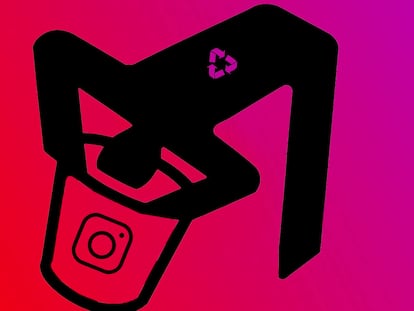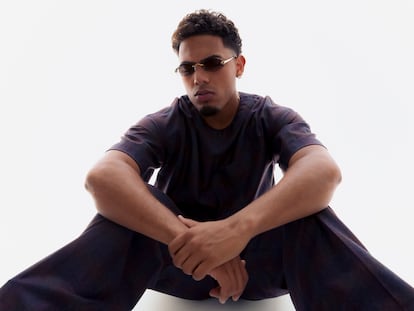Eladio Carrión: ‘Teachers should be paid like doctors, they are the ones who are molding people’
No one does trap like the Puerto Rican Eladio Carrión, who started making funny videos on social media and is now selling out stadiums across the world, cleverly sidestepping the clichés of his genre
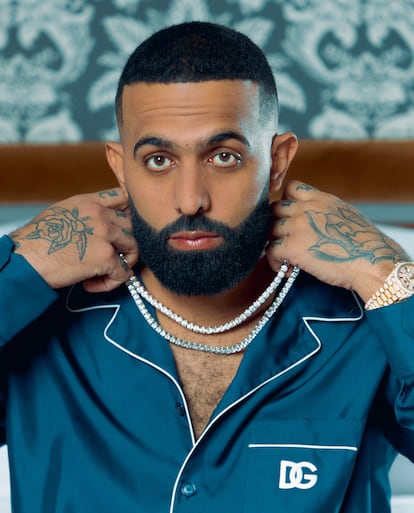
“Yesterday I went to Kanye’s concert. He is my favorite artist, the biggest inspiration for my music. I barely recorded three videos and I didn’t even look at the cell phone when I did it,” says Eladio Carrión in a luxurious hotel room in Madrid, fresh from Paris Fashion Week. He dresses like the urban music star that he is: headphones over one ear, a loose black leather jacket from Off-White, an oversized sweatshirt, jeans, black clogs and, of course, his huge diamond watch on his left wrist. With a solid build — he was a professional swimmer representing Puerto Rico — deep voice, large hands, tattoos and a neatly trimmed beard, he is impressive. But he relaxes as soon as he sits in a velvet armchair next to the enormous bed where his press team is relaxing in silence, and with their own tape recorder.
Using cell phones at concerts is something that obsesses him: “I understand that there are people who want to have their memories, but if it were up to me I would have the phone taken off them for the entire concert,” he says. “We are glued to our cell phones. There are people who watch entire concerts through it. It is incredible, and the energy that is transmitted to the artist is different. We’re on social media too much. We want to post everything we experience instead of living it.”
Recently, a video of one of his live shows in Costa Rica went viral. In it, he asked his fans not to record while his song Mbappe was playing. It was such an unusual request that he remembers it as almost countercultural. “It was like they were in Woodstock [laughs]. No phone, everyone jumping and bouncing like crazy.” In May and June he will be on tour in 11 Spanish cities and another six European cities. He has already announced several sold-out concerts. Will you ask the audience to turn off their cell phones? “Claaaro, brother,” he exclaims. “It’s the first time I’ve toured here. I’m really looking forward to it.”
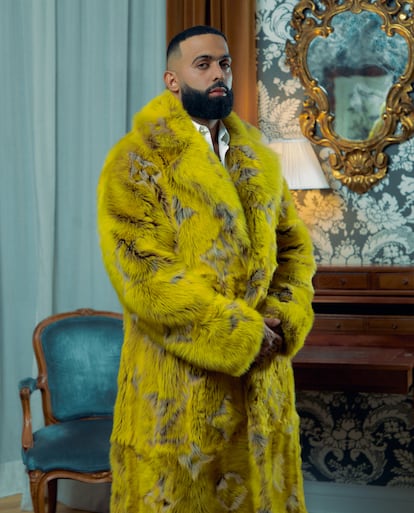
Until now Carrión had only performed in Spain at festivals, but that, he says, is not even close: “A 40-minute live show is nothing like one that lasts almost two hours. Spain deserves a little showcito from me. We’re going to see [the vibe] in Italy and Switzerland, but [in Spain] they have been [following] me for a long time and they deserve it. There is nothing better than putting on a show. Today you can buy views, but you can’t buy the emotions that people feel with your music. Sometimes I’m amazed that my fans know all my songs word for word.”
Over 21.6 million people per month listen to Eladio Carrión on Spotify, and his music has garnered more than five billion views across different digital platforms. With TQMQA (acronym in Spanish for “I love you more than yesterday”), the first single from his new album, Sol María, was his first song to reach number one in the United States on Billboard’s Latin Pop Airplay. He performs reggaeton, rap, dembow, and even R&B and Jersey club (electronic music), but he is known above all for trap. In fact, there are those who consider him a Spanish-language trap artist par excellence. And among these authoritative voices is one of his admirers and compatriots, Bad Bunny: “I got out of trap a while ago. I left it to Eladio,” he sang last year in MONACO, the first single from his latest album.
Reggaeton está cabrón, it’s a good genre to convey happiness and get played on the radio, but it does not give me the opportunity to express myself well.
The two met at the right time. Carrión was an influencer who had signed with Rimas, which was a small local company back then. Unsure about his future, he decided to enroll in the College of Cinematography, Arts and Television in San Juan, Puerto Rico. Apparently, when he walked through the door, Bad Bunny came out, then known only as Benito, and they became firm friends. Carrión, who boasts of having “a golden ear” for hits, heard the original version of the now legendary Diles, and it was he who told Noah Assad, the boss at Rimas, about little Benito. The rest is history.
Today, for Eladio Carrión the música urbana label is too broad. He prefers to talk about trap and hip hop. “It makes it easier for me to tell my story. It’s the challenge that I like: putting ten punchlines in eight bars, floating in a rhythm, offering references that people understand...” And he contrasts: “Reggaeton está cabrón, it’s a good genre to convey happiness and get played on the radio, but it does not give me the opportunity to express myself well. It’s more like a game of searching for that repetitive chorus, that melody.” Of course, for him it is also challenging to do it and for people worldwide to like it. If Carrión stands out for something, it’s his versatility. His tracks can be just as melodic as dance music, but he knows how to complement them with the narrative flow of rap lyrics. The themes range from self-improvement and redemption to the romantic and sexual. But he cleverly sidesteps the clichés of the genre.
The multi-platinum artist has recently entered a new stage in his life. He has just become the father of twins, who were born last November. They were born when, after several years of nominations, Carrión finally won the Latin Grammy for best hip hop song for Coco Chanel, along with Bad Bunny. Unfortunately, he couldn’t pick up the award, as the twins were born on the day of the gala, which was held in Seville, Spain. The fate of his sixth album, Sol María, released earlier this year is in the lap of the gods. Mama’s Boy, the last song on the album — which she performs with the Spanish rapper Nach — is dedicated to his mother, after whom he named the album. “I have a giant heart and it is because of how you have raised me,” sings Carrión. “It’s an album for her. I wanted to thank her through music,” he says now.
The album and his new family have made him reflect “about when they told me: ‘You will never understand this until you are a dad.’ Well, I now understand. I am having a super beautiful experience with my children, it is something inexplicable,” he responds with a smile from ear to ear. This sixth album confirms it. On it are the established talents of Latin American music such as Arcángel, De La Ghetto, Yandel, and Duki. But Carrión also supports emerging talent, like the teenager Milo J. With the young Argentine in La Canción Feliz Del Disco he appears happy, immune to possible criticism and, above all, relaxed. “Today I feel blessed and lucky,” he declares.
You have to value what you’re singing, because it carries a lot of influence, especially, on young children who are glued to YouTube. They are at an age when they take in all there is to learn.
Carrión claims his Puerto Rican identity. “I’m from the H, not [like] Travis. I have the salsa flow Héctor Lavoe,” he sings at the beginning of his session with Bizarrap. Eladio Carrión was the first Puerto Rican to record with the Argentine super producer. His song has had 220 million views on YouTube. The H is for Humacao, the town where he grew up, not Houston, the city where the world trap figure Travis Scott was born. Carrión has the best of both worlds. He was born in the United States and his first language was English. But, judging by how he speaks to his entourage, he jumps naturally between English and Spanish in his daily life. He is probably the Puerto Rican artist whose style comes closest to American hip hop, but he always raps in Spanish.
Puerto Rico is the island home of Bad Bunny, Myke Towers, Daddy Yankee, Arcángel, and Rauw Alejandro, with whom he has collaborated. Why does such a small place dominate the international scene? “It has always been the powerhouse of Latin urban music,” he responds. “There was even a time when if you weren’t from there, nobody took you seriously. Then very powerful artists came out from all over. We have influences from different cultures: the Caribbean, North America, and hip hop. There is a lot going on there on that little island. I think it’s because of everything we have around us, we adapt.”
The island is experiencing years of political instability. In 2019, Puerto Rican artists Ricky Martin, Residente, and Bad Bunny led protests against Governor Ricardo Roselló, who ended up resigning. The island’s current governor, Pedro Pierluisi, outsourced the ownership of the state electricity company to Luma Energy and there has been a rash of sudden power outages in the territory. Bad Bunny highlighted and criticized this whole situation in his video-documentary El Apagón (The Blackout). “I am Luma for my haters because I am not going to give them power,” says Carrión on Air France. “There have been many years of maladministration in Puerto Rico. It happens there and in many more places in the world.” He takes a moment and reflects, again, about the importance of education in a society: “In Puerto Rico, the education system is failing. They [the administration] are not supporting the teachers. In a perfect world I feel that teachers should be paid like doctors, because they are the ones who are molding people. But in Puerto Rico there are many good and bad things happening at the same time,” he says.
Carrión has also collaborated with superstars of the urban genre from outside the island. His influences are many: Future, Lil Wayne, and 50 Cent. He speaks as if he had it all thought out for years: “I already had the ‘feature’ in my head for every American I’ve collaborated with, and songs that I’ve saved for them. I know their tastes. I studied those artists a lot. I consumed them. I know their producers, what rhythms they were going to like…”
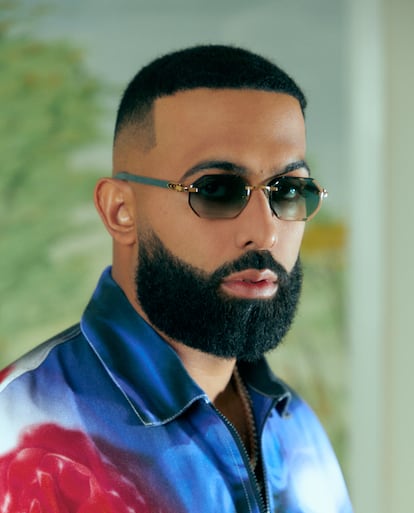
Tattooed on his right hand he has the logo of his first album, Sauce Boyz — a rose on a marijuana plant, he does not hide the fact that he loves cannabis. Many people got that same tattoo after the release of that album. When he hears that, Carrión smiles and pats his back twice. “It’s a movement. It is much more than music. When you treat music with love and respect, it becomes more than just a job or money. It has now become a commitment to society, to the community, and to my fans. In the end, you are an influence for these children and adolescents.” Over time, he is becoming an artist for the whole family. He says that he sees more and more parents with children at his concerts. Throughout his latest album he is aware of his responsibility as an artist. “You have to value what you’re singing, because it carries a lot of influence, especially, on young children who are glued to YouTube. They are at an age when they take in all there is to learn.” He confesses that he knows that there are songs that may have a “focus on ignorance,” but that he tries to provide a product that is pure.
During the transition to the artist he is today, he slept in cars and on the sofas of his friends in the studios. His ambition to achieve his dream was huge. After all his global successes, it is clear that he has earned a lot now. “I learned that money is not happiness,” he argues in Fé, Cojones y Paciencia. “Anyone who has made a lot of money and has gone through having it and not having it will tell you that it is not money that brings happiness. But anyone who has only lived with money won’t know that. Money doesn’t make you happy, it makes you comfortable. Happiness is when I see my babies smiling. I can’t pay them 20 pesos to get them to smile. You can’t buy that,” he says, smiling.
Carrión works hard. For him, a recording session of less than 12 hours “is not a session.” He takes ownership of the content of his songs and gives them his all to be a good influence and have hits. He considers himself a storyteller of the experiences that some people have: “I like to tell stories. I don’t like doing things for their own sake.” What satisfies you most about your job? “That people identify with the music is the best thing about art. I like to make people feel good at the end of the day.”
Have you ever felt empty with your success? “¡Qué va!” he responds quickly. “There is a lot more to do! I have the same hunger as the day I started. I’m still growing, thank God, and that is what I want.” And the future? “New music, great shows, and growing my beer brand, and SauceBoyz Fest,” he says, referring to his successful festival in Puerto Rico. The interview ends, he jumps up, shakes hands and says thank you. He quickly leaves the room with his team. The photographers are waiting to take his photos. But first he has an appointment with his trusted barber, newly arrived from Seville. First things first.
Direction: Alfredo Santamaría / Makeup and hair: Miky Vallés (Another Artist) / Photography assistant: Luis Calvo / Production assistant: Nicole Katzky
Sign up for our weekly newsletter to get more English-language news coverage from EL PAÍS USA Edition
Tu suscripción se está usando en otro dispositivo
¿Quieres añadir otro usuario a tu suscripción?
Si continúas leyendo en este dispositivo, no se podrá leer en el otro.
FlechaTu suscripción se está usando en otro dispositivo y solo puedes acceder a EL PAÍS desde un dispositivo a la vez.
Si quieres compartir tu cuenta, cambia tu suscripción a la modalidad Premium, así podrás añadir otro usuario. Cada uno accederá con su propia cuenta de email, lo que os permitirá personalizar vuestra experiencia en EL PAÍS.
¿Tienes una suscripción de empresa? Accede aquí para contratar más cuentas.
En el caso de no saber quién está usando tu cuenta, te recomendamos cambiar tu contraseña aquí.
Si decides continuar compartiendo tu cuenta, este mensaje se mostrará en tu dispositivo y en el de la otra persona que está usando tu cuenta de forma indefinida, afectando a tu experiencia de lectura. Puedes consultar aquí los términos y condiciones de la suscripción digital.
More information
Archived In
Últimas noticias
Most viewed
- Sinaloa Cartel war is taking its toll on Los Chapitos
- Oona Chaplin: ‘I told James Cameron that I was living in a treehouse and starting a permaculture project with a friend’
- Reinhard Genzel, Nobel laureate in physics: ‘One-minute videos will never give you the truth’
- Why the price of coffee has skyrocketed: from Brazilian plantations to specialty coffee houses
- Silver prices are going crazy: This is what’s fueling the rally

